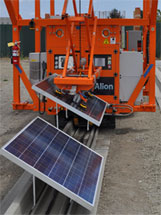More than anything else, the solar industry remains laser-focused on reducing the price. Even though costs for solar systems have plunged in recent years, that’s not enough to out-compete natural gas.
As we’ve reported on at length, efforts are underway on many fronts to get solar costs down, from reducing permitting costs to automating the sales process online.
Another method that has great potential is the use of robots, which at least several start-ups are focused on.
So far, the idea is to make constructing and operating large solar plants much cheaper and more efficient.
Alion Energy thinks it has a solution for the expensive, tedious process of building a large solar farm. Right now, those thousands of solar panels are screwed into the ground using human hands, one by one.
But Alion says "Rover" and "Spot" could do the job easier and cheaper.
Although we often think of solar energy as futuristic and high tech, building a solar plant is about as basic as it gets. Hundreds of employees are needed to first level the ground and drive in metal posts and then manually attach each solar panel to those posts and wire them into the system.
Once built, employees monitor the "farm," keeping weeds out and washing the panels clean. They drive along rows of solar panels, often for miles, trimming vegetation that can block the sun and cleaning dust off of panels.
If robots are used instead, the ground doesn’t have to be level, completely eliminating one huge step. The same kind of machine that lays sidewalks spits out a long concrete track, then Rover simply installs the panels and glues them in place. Humans then come in and wire the solar panels.

Spot does the cleaning. The robot travels along the rows squirting water on the panels and then squeegees them clean. Spot can also trim the vegetation using a regular-old hedge trimmer.

Rover and Spot not only significantly reduce labor costs, they can cut construction time by as much as half. Developers appreciate that because interest on loans accrues while projects are being built.
Using concrete is much cheaper than steel and frequent cleaning can yield 12.5% greater electricity production.
Add all this up and you’ve got some huge cost savings. Alion says its robots cut installation costs as much as 75%. And that’s on top of the drop in solar energy prices from utility-scale plants – more than two-thirds over the past five years in the US west.
SunPower just acquired Greenbotics, another company that makes panel-cleaning robots. The robots save 90% of the water used by replacing pressure washers and sprayer trucks, which also cuts the cost in half. And clean solar panels boost energy yield by as much as 15%, especially in dry, dusty regions.
Another California start-up, QBotix, comes in after the farm is built. Its robots travel along the rows of solar panels making sure they’re at the right tilt. Exacting optimization to grab the most sun can increase energy output as much as 40%.

Two robots can control 300 kilowatts of solar panels, reducing the cost of materials and eliminating the need for individual tracking motors that control various parts of an array.
Besides producing a lot more energy at big solar farms, this gives developers an option of building smaller solar plants that still achieve their production goals.
Meanwhile, Sunrun has been awarded $1.6 million (from DOE’s SunShot Initiative) to design the solar industry’s first end-to-end automated workflow system. The platform will streamline the design, workflow, processing, pricing, and project management of home solar projects.
Last year, Sunrun acquired Lightmile, whose software automates the process of designing solar systems. Without specialized training, sales professionals can create designs in minutes, avoiding multiple site visits. The software generates shade analysis, energy simulations, bills-of-material, system costs, proposals and contracts.
